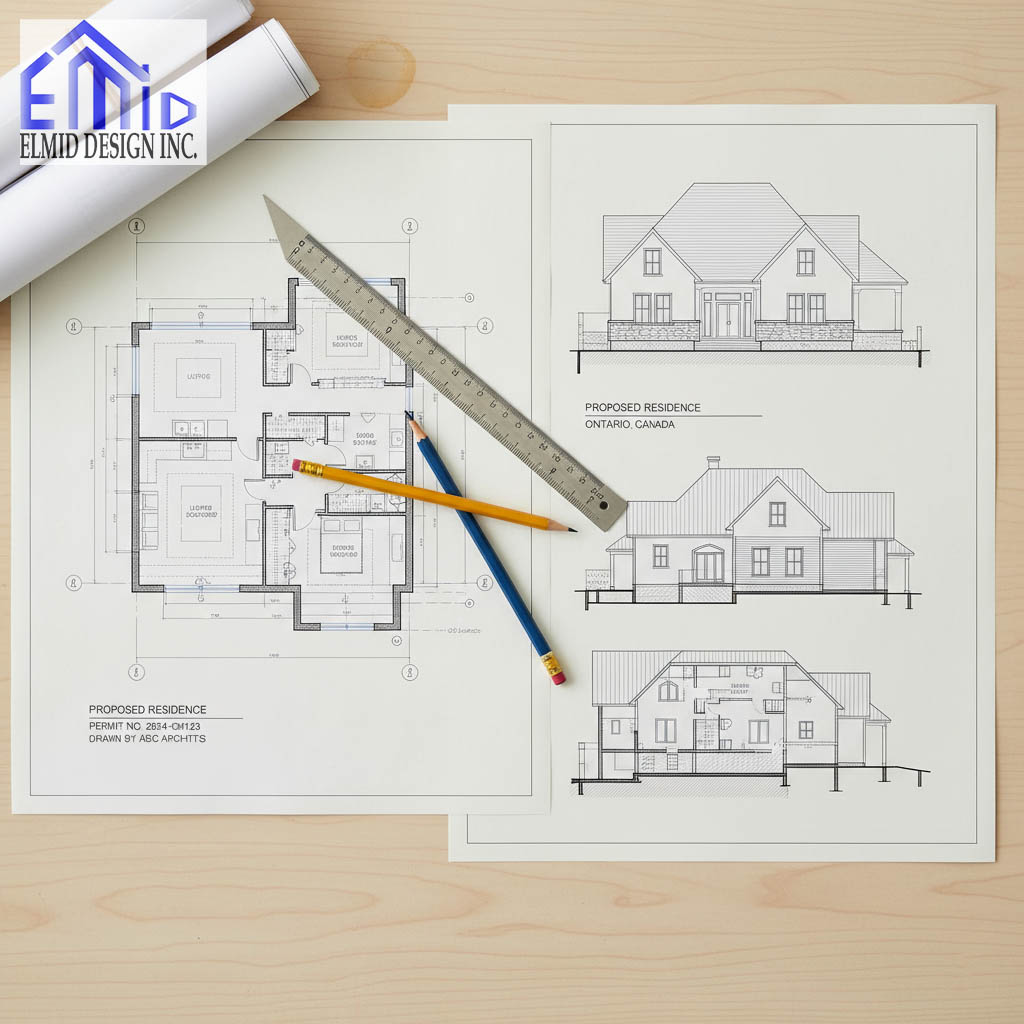Understanding building permit drawings Ontario is essential for any homeowner planning construction, renovation, or structural changes anywhere in the province. Many homeowners begin a project without knowing how detailed these drawings must be or how closely municipalities review each component before approving a permit. Building permit drawings Ontario serve as the blueprint that guides safety, structure, zoning compliance, and legal requirements across every community. This guide explains how these drawings work, why they matter, and what homeowners must include to move their projects through Ontario’s approval system smoothly. It also shows how working with a qualified engineering company such as Elmid Design Inc, which holds a Certificate of Authorization from Professional Engineers Ontario, helps you avoid delays, costly revisions, and unnecessary stress. If you want a faster approval process and a safe, compliant project, you must understand each part of building permit drawings Ontario.
What Building Permit Drawings Ontario Represent
Building permit drawings Ontario represent the official plan set that municipalities across the province rely on to evaluate construction proposals. These drawings explain what you intend to build, how you will build it, and whether the finished structure will meet the provincial building code. They show everything from structural framing to layout design in a clear and organized format. When the drawings follow the required standards, municipalities can assess safety, zoning compliance, and long-term durability. Building permit drawings Ontario also serve as a contract of sorts between you, the reviewer, and the contractor because they define exactly what will be constructed. Without these drawings, no municipality can approve a project, and no construction can begin.
Why Building Permit Drawings Ontario Are Required
Building permit drawings Ontario are required because they help protect homeowners, future occupants, and surrounding properties. Municipalities must confirm that any new construction or renovation aligns with the Ontario Building Code, zoning bylaws, and proper engineering standards. These drawings prevent dangerous structural changes, unsafe layouts, and design mistakes that could compromise a building’s integrity. They also reduce the risk of fire hazards, moisture problems, improper load distribution, and poor ventilation. When building permit drawings Ontario include all required information, the approval process is smoother, faster, and more predictable. The drawings act as the foundation of the entire project and serve as a long-term legal record.
When You Need Building Permit Drawings Ontario
You need building permit drawings Ontario whenever a project involves structural modifications, new construction, or significant changes to a building’s layout. This includes adding rooms, modifying load-bearing walls, constructing garages, expanding decks, finishing basements, building accessory structures, or adding new suites. Most municipalities also require drawings for plumbing changes, HVAC upgrades, and electrical modifications when they affect structural or safety systems. Because requirements vary across Ontario, preparing building permit drawings Ontario early helps you avoid delays. Homeowners often discover that even small projects require drawings when they influence safety or code compliance.
What Building Permit Drawings Ontario Must Include
Building permit drawings Ontario must include a site plan, floor plans, elevations, sections, and structural details. These components allow municipalities to understand the full scope of the project. The site plan shows property boundaries, existing structures, and proposed changes. Floor plans show interior layouts and explain what will be modified. Elevations display exterior views that reveal height, roof design, and spatial relationships. Sections show the building’s structural layers from the ground up. Structural details explain beams, joists, posts, and load-bearing features. Each part must be accurate so municipalities can verify that the structure meets safety and zoning expectations.
Why Accuracy Matters in Building Permit Drawings Ontario
Accuracy matters in building permit drawings Ontario because even minor errors can delay the entire project. When measurements are inconsistent or labels are unclear, the reviewing municipality cannot approve the drawings. This leads to revision requests that slow the project by days or even weeks. Accurate drawings also help prevent construction mistakes because contractors rely on them for every decision they make on site. When the drawings match real-world measurements and code expectations, the project moves more smoothly from design to approval. Clear and accurate building permit drawings Ontario help control costs, reduce confusion, and shorten approval timelines.
How Professionals Create Building Permit Drawings Ontario
Professionals create building permit drawings Ontario by measuring the property, analyzing zoning rules, and applying building code knowledge. This process begins with a detailed site assessment where professionals verify dimensions and structural conditions. They then research municipal bylaws to confirm how far structures must sit from property lines, how large they may be, and how they must be designed. Using digital design tools, professionals prepare scaled drawings that show layout, structure, and code-compliant construction methods. When structural work is required, engineers provide calculations and certified notes. This level of care results in building permit drawings Ontario that municipalities can approve with confidence.
Why Homeowners Choose Elmid Design Inc for Building Permit Drawings Ontario
Homeowners choose Elmid Design Inc for building permit drawings Ontario because the company delivers accurate, complete, and fully code-compliant plans. With a Certificate of Authorization from Professional Engineers Ontario, Elmid Design Inc offers structural engineering expertise that ensures every design meets safety and zoning requirements. Their team prepares drawings with clear layouts, precise measurements, and strong structural details. This approach reduces revision requests and moves projects through municipal review more efficiently. Homeowners value Elmid Design Inc because the company provides reliable support from planning through permit submission.
Common Mistakes in Building Permit Drawings Ontario
Common mistakes in building permit drawings Ontario include missing measurements, unclear labels, incorrect scaling, and incomplete structural information. Some homeowners forget to include existing floor plans, which makes it difficult for municipalities to understand what is being changed. Others include vague elevations that fail to show accurate heights or exterior finishes. A common problem is failing to show zoning compliance, such as building setbacks or lot coverage. When these mistakes appear in building permit drawings Ontario, municipalities return the plans for corrections, leading to major delays. Preparing complete drawings reduces frustration and speeds up approval.
How Building Permit Drawings Ontario Affect Timelines
Building permit drawings Ontario affect timelines because approval depends on the clarity and completeness of the drawings. When drawings follow municipal and provincial rules, reviewers can approve them faster. Incomplete drawings force reviewers to send revision notices, which extend the approval timeline significantly. Each correction adds time and increases the risk of construction delays. Homeowners who invest in strong building permit drawings Ontario often begin their projects sooner and avoid unexpected complications. The quality of the drawings becomes one of the most important factors in how fast the permit is issued.
How Zoning Influences Building Permit Drawings Ontario
Zoning influences building permit drawings Ontario by setting limits on building height, lot coverage, and setbacks. Each municipality has its own zoning rules that determine what can be built and where it can be placed. Drawings must show accurate measurements so reviewers can confirm compliance. When a design exceeds zoning limits, homeowners must seek variances, which adds time and complexity. Preparing building permit drawings Ontario with proper zoning research prevents redesigns and improves the approval process.
Why Ontario Building Code Requirements Shape Building Permit Drawings Ontario
Ontario Building Code requirements shape building permit drawings Ontario because the code establishes safety standards for every structure in the province. The code influences insulation levels, structural integrity, ventilation quality, foundation design, and fire protection systems. When drawings follow these rules, municipalities can approve them confidently. When they do not, revisions are required. Designers and engineers must understand how the code applies to each component of the design. Proper planning ensures that building permit drawings Ontario satisfy all necessary requirements.
How Structural Design Supports Building Permit Drawings Ontario
Structural design supports building permit drawings Ontario by showing how the building will withstand loads, forces, and environmental conditions. When a project involves beams, joists, or major layout changes, structural calculations must be included. Engineers provide detailed notes and certified designs that meet safety standards. Elmid Design Inc offers this engineering support to homeowners across Ontario. Structural clarity helps municipalities review the project efficiently and gives contractors a reliable plan to follow during construction.

How Property Conditions Shape Building Permit Drawings Ontario
Property conditions shape building permit drawings Ontario because each site has unique soil, grading, and drainage characteristics that affect structural design. A steep lot may require reinforced foundations, while poor soil may require wider footings or engineered solutions. Water flow across the property also influences drainage planning and foundation protection. Designers must study these conditions before preparing any plans to ensure the drawings match the physical realities of the site. When property conditions are understood early, the drawings move more smoothly through municipal review because they reflect real construction needs.
Why Contractors Depend on Building Permit Drawings Ontario
Contractors depend on building permit drawings Ontario because these documents guide every step of construction. The drawings show structure, layout, materials, and measurements in a clear and organized format that reduces confusion. Contractors use the drawings to estimate materials, schedule labour, and coordinate work with trades. When drawings are accurate, the contractor can follow them confidently. When drawings are unclear, delays and mistakes happen. Strong building permit drawings Ontario support safe construction, accurate costing, and consistent results from start to finish.
Why Clear Elevations Matter in Building Permit Drawings Ontario
Clear elevations matter in building permit drawings Ontario because elevations show how the finished building will appear from all sides. Elevations display roof lines, window spacing, siding materials, and height relationships that help municipalities verify zoning compliance. Contractors rely on these drawings to match exterior details during construction. When elevations lack clarity, misunderstandings occur that lead to costly corrections. Detailed elevations ensure that everyone understands the visual outcome of the project and that the design remains consistent with municipal expectations.
The Value of Cross Sections in Building Permit Drawings Ontario
Cross sections add value to building permit drawings Ontario because they reveal internal construction elements that cannot be seen in regular floor plans. Cross sections show framing, insulation, floor systems, and roof assemblies. These details help reviewers confirm that the structure meets the Ontario Building Code. Contractors also rely on cross sections to understand how to assemble various components safely. Strong cross sections support clear communication between the designer, reviewer, and builder, which reduces the risk of construction errors.
How Energy Efficiency Affects Building Permit Drawings Ontario
Energy efficiency affects building permit drawings Ontario because the Ontario Building Code requires specific insulation levels, air barriers, window performance standards, and ventilation systems. Drawings must show these energy details so reviewers can confirm compliance. Proper documentation helps keep heat loss under control and ensures comfortable indoor conditions. When energy details are missing, the reviewer must request more information, which delays approval. Including accurate energy details in building permit drawings Ontario helps both the homeowner and the municipality maintain high performance standards.
How Weather Conditions Influence Building Permit Drawings Ontario
Weather conditions influence building permit drawings Ontario because structures must withstand snow loads, wind exposure, and temperature shifts that vary across the province. Northern regions may require stronger roof framing to support heavy snow, while coastal or open areas may face high winds that affect wall and roof connections. Structural designs must consider these local climate demands. When the drawings reflect these conditions, municipalities can approve the project with confidence. This helps ensure long-term safety and structural reliability.
How Technology Improves Building Permit Drawings Ontario
Technology improves building permit drawings Ontario by allowing designers to produce precise, clean, and scalable plans. Digital drafting tools help eliminate errors and make revisions easier to manage. These tools also allow for three-dimensional modeling, structural simulation, and improved coordination between architects and engineers. Municipalities benefit from digital submissions because they review consistent, well-organized files. Technology elevates the quality of building permit drawings Ontario and makes communication throughout the project more efficient.
Why Documented Construction Methods Support Building Permit Drawings Ontario
Documented construction methods support building permit drawings Ontario by explaining exactly how each part of the structure must be assembled. Details about framing, insulation layers, material types, and fastening techniques help reviewers confirm code compliance. These methods also help contractors carry out each task correctly without guesswork. When construction methods are clearly documented, inspections become easier, and the project moves forward without unnecessary delays. Strong documentation enhances safety and improves long-term building performance.
How Building Permit Drawings Ontario Support Long-Term Safety
Building permit drawings Ontario support long-term safety by defining the structural systems, ventilation paths, and foundational elements that keep a building secure. These drawings help municipalities evaluate whether the structure can handle weight, moisture, and climate stress. They also help contractors avoid shortcuts that would compromise safety. Clear drawings maintain a consistent standard of quality across every stage of construction. Homeowners benefit from a safer building that remains durable for years to come.
How Building Permit Drawings Ontario Influence Property Value
Building permit drawings Ontario influence property value because they provide legal proof of proper design and construction. Buyers often request permit documentation when evaluating a home, especially when recent renovations are involved. Approved drawings show that the work met code and passed inspections. This builds trust and increases buyer confidence. Strong documentation also makes future upgrades easier because designers can build on the existing plans. Homes with clear building permit drawings Ontario generally maintain their value better than those without proper records.
How Accessibility Standards Influence Building Permit Drawings Ontario
Accessibility standards influence building permit drawings Ontario because homes must support safe movement for people with different mobility needs. Designers consider doorway widths, hallway spacing, landing sizes, and bathroom layouts to meet code requirements. These elements help prevent injuries and create a comfortable living space for all users. When accessibility details are integrated early, municipalities can confirm that the project aligns with provincial rules. Proper planning helps the homeowner remain compliant while improving long-term function and home value.
How Mechanical System Planning Shapes Building Permit Drawings Ontario
Mechanical system planning shapes building permit drawings Ontario because heating, cooling, and ventilation systems must follow specific code guidelines. Drawings must show duct layouts, furnace placement, exhaust routes, and airflow patterns. These details help maintain indoor air quality and reduce moisture risks. When the mechanical plan is clear, the municipality can evaluate performance and safety easily. Contractors also benefit because the layout directs installation without confusion. Solid mechanical planning helps avoid delays during inspection or construction.
Why Plumbing Layouts Matter in Building Permit Drawings Ontario
Plumbing layouts matter in building permit drawings Ontario because every drain, supply line, and vent must meet building code requirements. Proper plumbing planning prevents water damage, backflow issues, and sanitation problems. Drawings show fixture locations, pipe sizes, and routing to help reviewers confirm the system is safe and efficient. Clear plumbing layouts also help contractors install the system correctly during construction. When the plumbing plan aligns with code, the approval process becomes faster and more predictable.
How Fire Safety Requirements Shape Building Permit Drawings Ontario
Fire safety requirements shape building permit drawings Ontario because municipalities must confirm that buildings include proper fire protection features. Drawings show fire separations, smoke alarm locations, egress routes, and material ratings. These components help limit fire spread and keep occupants safe during emergencies. When fire safety elements are clear, the reviewer can approve the drawings with confidence. Homeowners benefit from enhanced safety and reduced insurance concerns.
How Future Design Flexibility Supports Building Permit Drawings Ontario
Future design flexibility supports building permit drawings Ontario because homeowners often want spaces that can adapt over time. Designers may plan for future basement finishes, room additions, or structural expansions. This approach includes strategic beam placement, accessible mechanical routes, or modular wall designs. When the drawings allow for future upgrades, the building becomes easier to modify without major structural changes. This planning also increases property value and long-term usability.
Why Architectural Style Matters in Building Permit Drawings Ontario
Architectural style matters in building permit drawings Ontario because municipalities want buildings that maintain neighbourhood appeal. Drawings must show exterior finishes, window proportions, rooflines, and design elements that match local expectations. Reviewers use these details to confirm the project blends with surrounding homes. Consistent architectural planning helps avoid design conflicts and speeds up approval. It also improves curb appeal and supports the value of the property.
How Accurate Site Plans Strengthen Building Permit Drawings Ontario
Accurate site plans strengthen building permit drawings Ontario because they show the project’s placement on the property. These plans reveal setbacks, lot boundaries, grading details, and drainage paths that affect zoning compliance. When site plans are precise, municipalities can evaluate the project quickly. Inaccurate site plans often lead to immediate rejection or revision requests. Proper site planning ensures that the proposed construction respects municipal bylaws and natural features of the property.
How Building Permit Drawings Ontario Guide Inspections
Building permit drawings Ontario guide inspections by providing a clear reference for inspectors at each construction stage. Inspectors compare the work on site to the approved drawings to confirm compliance. This includes checking framing, insulation, mechanical systems, and safety features. When drawings are complete and clear, inspectors can perform their work efficiently. If the construction does not match the drawings, corrections are required before the project can continue. Strong drawings help create a smoother inspection process.
How Building Permit Drawings Ontario Reduce Construction Risks
Building permit drawings Ontario reduce construction risks by giving contractors a detailed plan that eliminates guesswork. Risks such as structural failure, moisture problems, or unsafe layouts are reduced when drawings show accurate dimensions, structural details, and proper materials. Homeowners gain confidence because the design follows proven standards. Municipalities benefit because compliant drawings lead to safer communities. These drawings form a safety foundation that supports every stage of the project.
FAQ About Building Permit Drawings Ontario
What are building permit drawings Ontario
Building permit drawings Ontario are detailed plans required by municipalities to approve construction or renovation projects. They include site plans, floor layouts, elevations, sections, and structural details needed to confirm safety and code compliance.
Who prepares building permit drawings Ontario
Building permit drawings Ontario are prepared by designers, architects, engineers, or qualified design firms. When structural changes are involved, homeowners often rely on an engineering company such as Elmid Design Inc to ensure accuracy and compliance.
How long does approval take for building permit drawings Ontario
Approval time varies by municipality and project complexity. Clear and complete drawings move through review faster, while missing details or zoning issues cause revision delays.
Do small projects require building permit drawings Ontario
Many small projects require building permit drawings Ontario if they affect structure, plumbing, electrical systems, or safety conditions. Municipal building departments can confirm specific requirements.
Why are structural details important in building permit drawings Ontario
Structural details are important because they show how the building will handle loads safely. Municipalities check these details to ensure compliance with the Ontario Building Code and long-term structural strength.

Why Ontario Homeowners Trust Elmid Design Inc for Permit Drawings
Elmid Design Inc helps homeowners across Ontario prepare accurate and code-compliant building permit drawings Ontario with dependable engineering expertise. As a company holding a Certificate of Authorization from Professional Engineers Ontario, it delivers precise structural details, clear layouts, and reliable guidance that support faster municipal approval. Homeowners value Elmid Design Inc for its professionalism, attention to detail, and commitment to safe, compliant, and well-designed projects across the province.
Geographic Locations That We Service:
Our Licensed Professional Engineers specializing in Engineered Site Grading Plans offer the best-engineered site grading plan, lot grading and erosion plan, and drainage plan to obtain site plan approval and building permits in Ontario, including a wide range of municipalities. Each area boasts unique features and requirements, making our tailored approach essential for success.
Toronto and Surrounding Areas
In the vibrant heart of Ontario, we service Toronto (City of Toronto) and surrounding areas. Additionally, we cover Oshawa (City of Oshawa), Pickering (City of Pickering), and Clarington (Municipality of Clarington). Furthermore, our expertise extends to Ajax (Town of Ajax), Whitby (Town of Whitby), Brock (Township of Brock), Scugog (Township of Scugog and Uxbridge (Township of Uxbridge).
Halton Region
Moving to the Halton Region, our services encompass Burlington (City of Burlington) and Halton Hills (Town of Halton Hills). Also included are Milton (Town of Milton) and Oakville (Town of Oakville).
Peel Region
In the Peel Region, we provide services in Brampton (City of Brampton), Mississauga (City of Mississauga), and Caledon (Town of Caledon).
York Region
Our services in the York Region cover Vaughan (City of Vaughan), Aurora (Town of Aurora), and East Gwillimbury (Town of East Gwillimbury). We also cater to Georgina (Town of Georgina), Markham (City of Markham), Newmarket (Town of Newmarket), Richmond Hill (City of Richmond Hill), Whitchurch-Stouffville (Town of Whitchurch-Stouffville), King (Township of King), and Bradford-West Gwillimbury (Town of Bradford-West Gwillimbury). Each municipality here offers a distinct setting, requiring our specialized approach.
Other Southern Ontario Cities and Towns
We also serve many other cities and towns in Southern Ontario. These include Hamilton (City of Hamilton), St. Catharines (City of St. Catharines), Niagara on the Lake (Town of Niagara on the Lake), Brant (County of Brant), Cambridge (City of Cambridge), Kitchener (City of Kitchener), Waterloo (City of Waterloo), and Woodstock (City of Woodstock). Furthermore, we operate in Guelph (City of Guelph), Centre Wellington (Township of Centre Wellington), Shelburne (Town of Shelburne), Orangeville (Town of Orangeville), New Tecumseth (Town of New Tecumseth), Essa (Town of Essa), Collingwood (Town of Collingwood), Wasaga Beach (Town of Wasaga Beach), Barrie (City of Barrie), Midland (Town of Midland), Orillia (City of Orillia), Ramara (Town of Ramara), Minden Hills (Town of Minden Hills), North Kawartha (Town of North Kawartha), Kawartha Lakes (City of Kawartha Lakes), Peterborough (City of Peterborough), Selwyn (Town of Selwyn), and Brighton (Municipality of Brighton).




